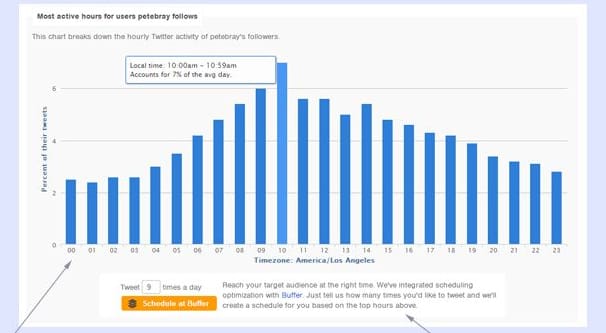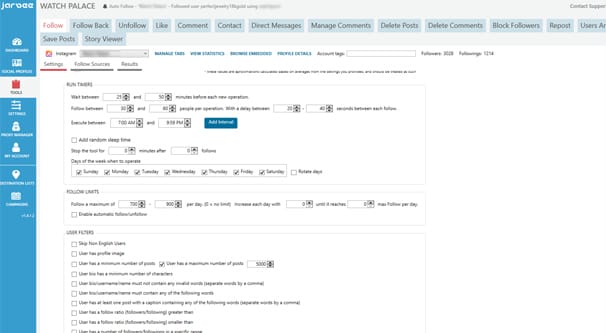In the world of social media automation, there are a huge variety of different programs you can use, with all different levels of automated practices. Some of them are little more than putting lists, analytics, and schedules in front of you on one dashboard. Some of them go all the way into botting your entire account for you, so you don’t even have to look at it while it grows. Some are white hat, sanctioned by the network it’s used for, given permission via the API. Some of them require huge lists of proxies, monitoring for rate limits, Captcha-breaking apps and stealthy actions to avoid being banned.
Jarvee is a Twitter automation app with calls to action on its homepage like “Schedule Your Posts and Grow All Your Social Accounts 10 Times Faster Than Before!” So the question is, is Jarvee one of those white hat tools, or is it a trap for people who want to skip the legwork and go right to success?
What is Jarvee?
Jarvee is an all-around social media automation tool that works for a bunch of different networks. Though we’re primarily concerned with Twitter right now, Jarvee works on Facebook, Instagram, YouTube, Twitter, Google+, Pinterest, LinkedIn, and Tumblr. I’m just going to go over what they do for Twitter, but suffice it to say that Jarvee has many of the same features for every social network it hooks into. What features does Jarvee have for Twitter?
- Post Scheduling. Jarvee allows you to set up a schedule for all of your future tweets, months in advance. There’s nothing unique about this; virtually every Twitter app that manages posting has scheduling options, including native Twitter itself.
- Twitter Mentions. This feature allows you to select a list of Twitter users who are part of your target audience, and use the @mention feature to tag them specifically in your messaging.
- Auto-Following. Using keywords, hashtags, and noun mentions, you can build a list of potential followers and follow them automatically. This ideally entices them to check you out and, if your account is good enough, follow you in return.
- Auto-Unfollowing. When you follow users and they don’t follow you back, Jarvee can automatically unfollow them after a certain amount of time has passed.
- Auto-Followback. When someone follows your account, you follow them back. It’s meant to be a kind of soft reward for people who follow you.
- Auto-Retweets. Again using a list of hashtags and keywords, you can use Jarvee to find content that’s relevant to your niche, and retweet it. It keeps your feed active with semi-curated content of interest to your followers.
- Auto-Hashtagging. When you make a tweet through Jarvee, if it includes a keyword you have added to your auto-tagging list, the app will automatically convert it into a hashtag. This helps avoid missing opportunities to use a tag you might otherwise miss.
- Auto-Favorites. Similar to the auto-retweet feature, Jarvee will favorite those tweets when they retweet for you. It’s worth noting here that Twitter hasn’t called the action a Favorite in years, so Jarvee hasn’t bothered to update their copy since that change.
- RSS Tweeting. You can plug in an RSS feed and Jarvee will make tweets of new content, posting automatically. This feature is also pretty common amongst Twitter management apps, since a lot of your content is generally going to be promoting your own blog posts.
- Result Monitoring. I don’t think there’s a single Twitter management app out there that doesn’t have some kind of analytics built into it. Jarvee is no exception.
- Spin Syntax. If you want to post the same tweet 100 times, but with different words each time, you can do so using spintax.
- Proxy Support. If you’re running Jarvee on multiple accounts – or want plausible deniability for your one account – you can run the app through a web proxy to change up the IP and post source footprint.
- Targeted Direct Messages. You can use the same sort of keyword and hashtag searches you use for the retweet and “favorite” actions, and send direct messages to users.
- Canned Replies. When someone sends you a direct message or an @mention, you can use the app to automatically respond with some kind of canned message. The utility of this depends on the situation.
- Night Mode. The ability to set hours of operation, to turn off activity and make your account appear as though a human is running it rather than a piece of software.
There are plenty of problems with this list of features, but I’ll go over those in a couple sections. First, let’s take a look at some more details about the app itself.
What Does Jarvee Cost?
Jarvee is free to use for the first five days, after which you have to pay for the service. They have three tiers of plan, the only difference between them being the number of social media accounts you can automate with them. The cheapest plan, the Starter plan, is $20 per month and allows you to hook up 10 social media profiles across their list of networks. It could be 10 Twitter accounts, five Twitter and five Facebook, or any other distribution.
The Professional plan bumps that number from 10 to 70, and bumps the price from $20 to $50 per month. And, of course, the Premium level is $70 per month and increases the number to 150 social media accounts.
For the majority of my readers, you’d be looking at the $20 per month plan. The only people who care about the higher tier plans are the ones that are agencies automating other peoples’ accounts for them. You can certainly do this, if you like, and Jarvee is a decent enough way to do it. Just know that this kind of automation has a lot of potential drawbacks, and if you get a customer account banned, you’re going to rapidly lose business.
Are There Problems with Jarvee?
If you’ve read much on this side in the past, you know I’ve reviewed a handful of other similar apps for different social networks, as well as automation practices in general. I bet you can already see some of the issues with Jarvee, but regardless, I’m going run down all of them.
First up, the auto-mentioning people directly feature is creepy, unwanted, and a huge turn-off for most users. I don’t know about you, but if I’m just casually tweeting about some game I read about, or some product I was thinking about, I don’t want to be specifically called out by a mid-to-low-quality businesses trying to fish for my follow. If someone tags me in a post, I want to know that person and have a conversation with them.
Secondly, the auto-following thing relies entirely on follow-back culture. Follow-back culture was a relic of some of the early Twitter usage, where people were more used to Facebook’s reciprocal friendship. The practice was to follow anyone who followed you. Of course, this was incredibly abused and virtually everyone stopped using it. These days, about the only people who follow-back automatically are people who use bots like Jarvee to do it for them, in the mistaken impression that it’s still a valid thing to do. Want to know more? We covered this exact topic in detail already.
Next, the opposite action is a huge red flag. Automatic unfollowing of users who don’t follow you is one of the metrics Twitter analyzes directly and watches like a hawk. It’s the most identifiable part of follower churn, also known as the follow/unfollow method. This, too, is something we wrote about a long while back. The short version is: not only will this method not grow your Twitter account, it’s liable to get you banned. In fact, just look up Follower Churn in the Twitter help center; they explicitly forbid the practice.
The auto-followback feature only serves to get your account on a list of accounts that follow when they’re followed, which means your account will be exploited by people looking to get free follows. Of course, if those users then unfollow you, the bot recognizes that they’re no longer followers and will unfollow them, leading to a lot of worthless fluctuation and cyclical bot interactions between accounts running Jarvee or similar apps.
On top of that, when you’re following thousands of accounts, it very quickly makes your native Twitter feed an unreadable mess of crap you really don’t care about. You can get around this by using Twitter lists to build curated selections of users and just using those feeds, but that’s a big pile of extra effort you wouldn’t need to go through if you didn’t follow a bunch of people who really don’t matter.
I have to mention spintax here as well. Spinning content in some very rare instances can work fine, and Twitter can be one of those instances, simply because of how basic a tweet is and how little there needs to be in terms of consistency from one sentence to the next. Unfortunately, that also means it’s very easy to spin things yourself in a more coherent way. Plus, Twitter doesn’t really care if you duplicate posts. Hubspot, I think it was, did a study where they tweeted the same message something like 140 times and still got engagement on it due to how few people saw it each time. There’s not really a good reason for spinning a tweet, unless you’re just stealing your tweets from someone else, or trying to use Jarvee to post the same thing on 100+ accounts.
Proxy support isn’t itself a bad thing, but it’s another indication that the tool is gray-hat at best. Proxy server support only indicates two possibilities. The first is that you’re running a ton of different accounts and want them to appear as though different people are running them. In other words, you want to lie to Twitter to avoid detection. The other is if you’re taking actions you know are against the rules, and want to use an excuse like “a guy I hired to run my account was botting, I want to appeal the ban; I’ve fired him, so let me come back!”
The ability to reach out and direct message people based on keywords they use is, well, basically just spam. Unsolicited direct messages are spam and ban-worthy according to Twitter as well.
Using canned responses to mentions and direct messages can be fine in some cases, but can also be detrimental. If the same sort of reply is coming to everyone who mentions you, it’s pretty obvious that either a bot or a low-paid third world worker with a copy and paste script is behind it.
Since Twitter is probably the best social network in the world for customer service, it really hurts when you’re not using it the way people expect it to be used. Worse, if they call you out for botting your customer service and being hugely ineffective with it, you’re going to waste a lot of opportunities, lose social capital, and have a damaged reputation.
Finally, Jarvee is commonly mentioned on BlackHatWorld. This alone is not really enough to damn an entire app, but the fact that so many of the people posting about it are having issues with their platform of choice indicates some problems. Either the platforms, usually Twitter and Instagram, have detected the app behavior and figured out how to block it, or it’s incredibly easy to violate rules or rate limits and thus get banned for using the app.
So, if you want my final verdict, I’m going to tell you not to use Jarvee. It’s an app with a dozen different features that can hurt your profile or get you banned, and only a few that are worthwhile and safe to use. You can make use of it, if you’re very careful, but I would never trust it to a business account. Maybe a personal account or a fake account for a case study, but that’s about it.









Interesting post, but is there any good alternative to Jarvee? I guess you can make something of it with non-aggressive settings.
For full on automation, Jarvee is definitely the most popular tool to use. It can be abused though, and many people have lost their accounts using Jarvee. It’s important to be conservative with your automation and don’t push your account too hard like you said. If you’re hitting your posting and engagement limits every day and setting off a bunch of red flags you are at much higher risk than if you are gently growing a profile.